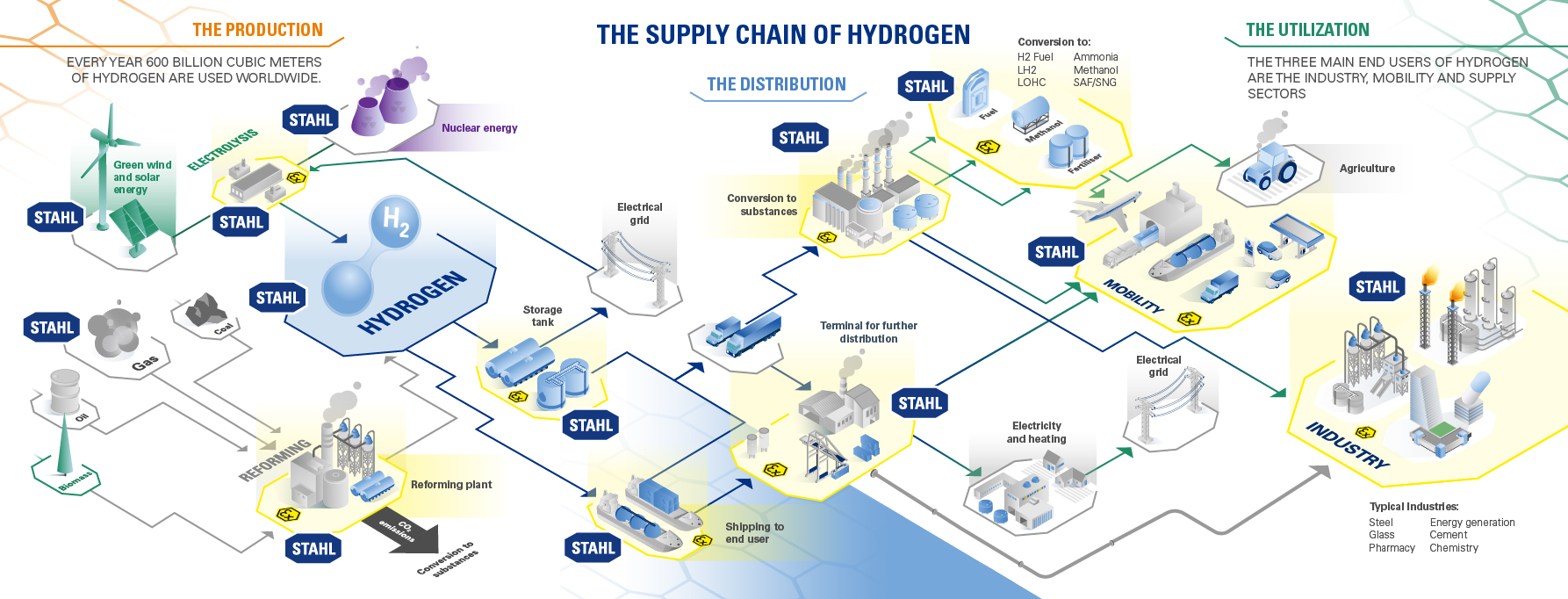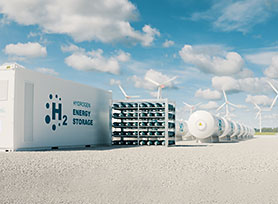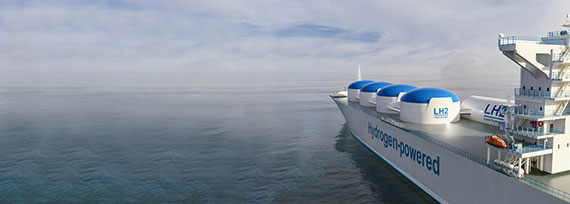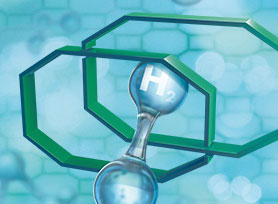#STAHL4HYDROGEN
The daily demand for energy worldwide is already very high. But how can we meet the eminent energy demand in the future with an ever faster growing population? In addition to this challenge, the share of fossil raw materials is also decreasing and the future energy supply should also become more CO2 neutral.
The answer is obvious: HYDROGEN
Hydrogen has emerged to play a leading role in the clean energy mix, when renewable energies are used and is already considered the fuel of the future. Hydrogen is ideal as an energy source and storage medium. Hydrogen can be produced in several different ways, the main ones being electrolysis of water atoms and steam reforming of natural gas. Hydrogen is no longer a niche sector, but it is developing rapidly.
However, Hydrogen is extremely flammable and builds enormous explosive energies. It burns extremely hot, with a flame that`s invisible to the human eye. New hazardous areas will emerge throughout the whole supply chain.
When it comes to the topic of safety and explosion protection, uncertainty and questions arise. Large plants require new explosion protection systems for all kinds of applications. But don't worry, because this is where we come in. We already have decades of experience in explosion protection for Hydrogen-based industries and have the best solution for your challenges.
R. STAHL is your green link.
Knowledge2GO
An Ex-citing future with Hydrogen
Hydrogen is seen as the future of the energy revolution, but it is a highly flammable and therefore dangerous substance. Read in our article about the properties of Hydrogen and how explosion can be effectively prevented in Hydrogen applications.
Standards in the development of a safe and reliable Hydrogen infrastructure
To develop a safe green Hydrogen economy, safety risks must be avoided. In our article you can read how the standardization organisations ISO and IEC support the progress to develop Hydrogen infrastructures internationally while maintaining the high standards of safety.
R. STAHL is part of the UK Hydrogen and Fuel Cell Association
R. STAHL is active in various projects and associations to support decarbonizing the industry to cleaner energies. Learn how we bring our knowledge and expertise from the last 100 years to help to realize a safe and net zero future of energy.


Frequently Asked Questions
1. What exactly is Hydrogen?
Hydrogen is the most abundant element on our planet. Hydrogen is a colourless, odourless gas. Mostly it is part of a compound, e.g with Oxygen (O2) it`s water (H2O).
Hydrogen has an extremely small size of molecules and a very low density. Compared to the density of air, Hydrogen is 14 times lighter.
Hydrogen is non-toxic and not radioactive. An explosion only occurs when flammable material, e. g. Hydrogen, comes in contact with oxygen and an ignition source. It burns extremely hot with an invisible flame as well with high energy. This might cause problems in the surrounding area, e. g. melting or other explosions.
There exists many different methods for producing Hydrogen, the most common is natural gas steam reformation, which produces H2 from Methan and water. Whatever method of producing is used, the Hydrogen must be split off from a Hydrogen-containing material with the help of chemical, thermal, electrical or solar power energy. With the help of electrolysis the production of Hydrogen is climate friendly as it causes no carbon dioxide (green Hydrogen). Currently, the proportion of Hydrogen generated through electrolysis is low, at around 5%, but is expected to increase significantly in the next couple of years.
2. How is Hydrogen produced?
Hydrogen can be produced in several different ways, the main ones being electrolysis of water atoms (2 H2O ––> 2 H2 + O2) and steam reforming of natural gas (CH4 + H2O ––> 3 H2 + CO).
3. What is green Hydrogen?
The principle of electrolysis is that water can be split into it`s combounds, Hydrogen and Oxygen. For the electrolysis electrical energy is needed. In most applications, this energy is produced by renewable energies, like wind and solar power. The outcome is green Hydrogen. This is currently the only method to produce Hydrogen sustainably and without any footprint. Hydrogen is an energy source and storage medium, so the energy can be stored and used later when it is needed.
The production of Hydrogen is divided into colours, e.g. grey Hydrogen is produced with the energy of Natural gas, crude oil or coal. Green colour means that only regenerative energy sources are used for production.
4. Is Hydrogen always green or could it be also blue?
Green Hydrogen means that the energy needed is used from renewable resources. Since this is not always the case, hydrogen is not always green - there are different colours, such as
- Grey Hydrogen is obtained from fossil fuels and natural gas is converted in Hydrogen and CO2 under heat (steam reforming). The CO2 is released unused into the atmosphere.
- Blue Hydrogen is similar to grey Hydrogen, but uses innovative techniques to reduce the amount of CO2 produced, which is then captured with CCUS (Carbon Capture Utilization and Storage). As this CO2 is not released in the atmosphere it can be considered as CO2 – neutral.
- Turquoise Hydrogen is produced by the thermal decomposition of methane (methane pyrolysis). Instead of CO2, solid carbon is captured.
5. Why do I need Ex protection for Hydrogen?
It requires a very low energy to ignite, which happens when a combustible material comes in contact with Oxygen and an ignition source. H2 combusts very fast and builds up extremely explosive energies. Wherever Hydrogen is handled, from storage to transportation to usage, hazardous areas will be created.
For any possible application explosion protection is needed to prevent H2 from being a hazard. The planned significant expansion and consolidation of Hydrogen create new safety related dimensions, which need to be considered along the entire value chain.
6. Which industries are affected?
It does not depend on specific industries, each industry is affected as soon as hydrogen is part of the process. That means explosion protection is neccessary:
- Producers and plants that use for example water electrolysis or methane reforming.
- Companies that transport and/or store hydrogen, e.g. transport in tanks or pipelines.
- End users need to think about and implement safety solutions. This applies not only to industries which will use Hydrogen in future and replace coal by Hydrogen for example, but it will also affect consumers such as fuel stations upgrading for customers who want to fuel their new low emission cars with Hydrogen.
The best Partner for explosion protection equipment in your H2 Future
For almost 100 years, R. STAHL has been setting trends in the field of safety solutions for hazardous areas. Our innovative products and integrated systems around the globe are always tailored to your needs. Available in any region of the world, with local support and service. Our customers benefit from our:
- Extensive, comprehensive explosion protection product range, including bespoke automation equipment, power engineering, lighting technology and maritime-specific, vibration-resistant products for the entire H2 supply chain and any possible application.
- Products and systems that can be used in extreme circumstances and withstand the harshest ambient conditions.
- Best consultancy - R. STAHL makes Hydrogen easy, thanks to decades of experience in international certified explosion protection for Hydrogen-based industries
- Future-oriented, innovative and long-term solutions.
- Outstandingly high-quality products for which R. STAHL is known, which correspond to the latest standards and have been granted sector-specific certificates.
- First-class quality management from design to build any system that meet your precise requirement.
- Worldwide consistent quality standards, regardless of production location.
- We are engaged in international committees and research groups to work on future technologies, and we collaborate with experts dedicated to innovation and advancement.










